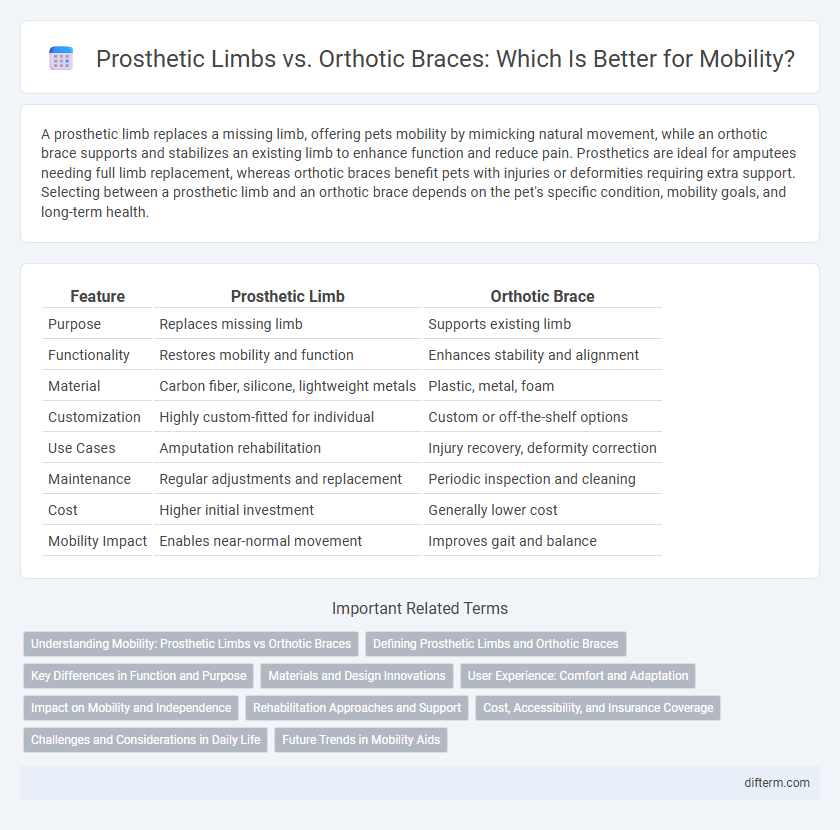A prosthetic limb replaces a missing limb, offering pets mobility by mimicking natural movement, while an orthotic brace supports and stabilizes an existing limb to enhance function and reduce pain. Prosthetics are ideal for amputees needing full limb replacement, whereas orthotic braces benefit pets with injuries or deformities requiring extra support. Selecting between a prosthetic limb and an orthotic brace depends on the pet's specific condition, mobility goals, and long-term health.
Table of Comparison
| Feature | Prosthetic Limb | Orthotic Brace |
|---|---|---|
| Purpose | Replaces missing limb | Supports existing limb |
| Functionality | Restores mobility and function | Enhances stability and alignment |
| Material | Carbon fiber, silicone, lightweight metals | Plastic, metal, foam |
| Customization | Highly custom-fitted for individual | Custom or off-the-shelf options |
| Use Cases | Amputation rehabilitation | Injury recovery, deformity correction |
| Maintenance | Regular adjustments and replacement | Periodic inspection and cleaning |
| Cost | Higher initial investment | Generally lower cost |
| Mobility Impact | Enables near-normal movement | Improves gait and balance |
Understanding Mobility: Prosthetic Limbs vs Orthotic Braces
Prosthetic limbs replicate the function of a missing limb, enabling users to regain mobility through advanced materials like carbon fiber and microprocessor-controlled joints. Orthotic braces support and stabilize existing limbs, improving alignment and reducing pain for conditions such as cerebral palsy or stroke-induced weakness. Comparing prosthetics and orthotics highlights essential differences in purpose, technology, and rehabilitation strategies critical for restoring patient mobility.
Defining Prosthetic Limbs and Orthotic Braces
Prosthetic limbs are artificial devices designed to replace missing body parts, restoring mobility and function with advanced materials and biomechanical engineering. Orthotic braces are external supports worn to correct or stabilize skeletal deformities, improve alignment, and assist weakened muscles without replacing any body parts. Both play crucial roles in mobility enhancement but serve distinct purposes based on whether limb replacement or structural support is required.
Key Differences in Function and Purpose
Prosthetic limbs replace missing body parts to restore mobility and functionality, often incorporating advanced robotics for natural movement. Orthotic braces support, align, or correct musculoskeletal deformities, enhancing existing limb function without replacing any part. The fundamental difference lies in prosthetics substituting absent limbs, while orthotics optimize the performance of impaired but present limbs.
Materials and Design Innovations
Prosthetic limbs increasingly utilize lightweight carbon fiber composites to enhance strength and flexibility, while orthotic braces integrate thermoplastics and silicone gels for improved comfort and adjustability. Advanced 3D printing technology enables customized, precision-fit designs in both prosthetics and orthotics, promoting better user mobility and functionality. Recent innovations include adaptive microprocessor-controlled joints in prosthetics and dynamic alignment features in orthotic braces, optimizing biomechanical efficiency during movement.
User Experience: Comfort and Adaptation
Prosthetic limbs offer a more natural range of motion and personalized fit, enhancing comfort for long-term use compared to orthotic braces, which typically provide external support and limit mobility. Users often report faster adaptation with prosthetics due to advanced materials and customizable designs that mimic natural limb function. Orthotic braces may cause discomfort during extended wear because of rigid structures, whereas prosthetic limbs utilize lightweight components and cushioning to improve user experience.
Impact on Mobility and Independence
Prosthetic limbs offer enhanced mobility by enabling amputees to perform a wider range of movements, significantly improving independence in daily activities compared to orthotic braces. Orthotic braces primarily support and stabilize existing limbs, which can limit the degree of mobility and functionality for users with severe impairments. Choosing between a prosthetic limb and an orthotic brace depends on the level of limb loss or dysfunction, mobility goals, and individual rehabilitation needs.
Rehabilitation Approaches and Support
Prosthetic limbs provide dynamic support by replacing missing limbs, facilitating functional mobility and enabling patients to regain significant independence during rehabilitation. Orthotic braces offer structural support and alignment correction, enhancing stability and reducing pain for individuals with impaired limb function but intact anatomy. Both rehabilitation approaches focus on personalized therapy and adaptive training to optimize patient outcomes and improve quality of life.
Cost, Accessibility, and Insurance Coverage
Prosthetic limbs generally entail higher costs ranging from $5,000 to $50,000 depending on functionality, while orthotic braces typically cost between $500 and $5,000, making braces more accessible for many patients. Insurance coverage varies significantly; prosthetics often require extensive documentation and prior authorization, whereas orthotic braces have more straightforward approval processes but may be subject to limited benefits. Accessibility to both devices depends on geographic location and provider availability, with prosthetics often requiring specialized clinics, whereas orthotic braces are more readily obtainable through standard medical suppliers.
Challenges and Considerations in Daily Life
Prosthetic limbs often require extensive adjustment periods and present challenges such as discomfort, skin irritation, and maintenance, impacting mobility and daily activities. Orthotic braces, while generally less invasive, can restrict movement and cause fatigue or pressure sores during prolonged use. Both devices demand personalized fitting and regular evaluation to ensure functionality and comfort within varied daily life scenarios.
Future Trends in Mobility Aids
Future trends in mobility aids highlight significant advancements in prosthetic limbs through integration of neural interfaces and smart materials, enabling more natural movement and sensory feedback. Orthotic braces are evolving with lightweight, adaptive designs using 3D printing and AI-driven customization to enhance user comfort and functionality. Both technologies converge towards personalized, responsive solutions that improve mobility outcomes and independence.
prosthetic limb vs orthotic brace Infographic

 difterm.com
difterm.com